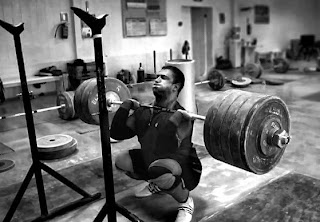The Decline Barbell Bench Press is a compound chest exercise that focuses on the lower heads of the pectoral muscles.It is a good exercise for hypertrophy as well as strength. Performing the Decline Bench carries some risks, so its use is not recommended for beginners. The movement should be performed with a spotter and clipped weights.
The decline bench press is closer to the kinesiology of a regular push up compared to the flat bench press, so the two movements are interchangeable to a certain extent .
Synergists
Dynamic Stabilizers
Grip
Range of motion(ROM)

performance
(sources:exrx.net)
The decline bench press is closer to the kinesiology of a regular push up compared to the flat bench press, so the two movements are interchangeable to a certain extent .
Contraindications :
- Avoid the movement if you have shoulder injuries.
Muscles
Target- Pectoralis Major, Sternal
Synergists
- Pectoralis Major, Clavicular
- Deltoid, Anterior
- Triceps Brachii
Dynamic Stabilizers
- Biceps Brachii, Short Head
Variations
The different options for the Decline Barbell Bench Press can be:- Power lifting method - most often aiming for the shortest range of motion
- Classic - full ROM
- Shoulder (shoulders are forward and inward toward the ears) - Stay away from this one! If you're looking to train your shoulders consider other more reasonable exercises.
Grip
- The decline press must only be done with a locked grip, never utilize the thumb less(suicide) grip while performing this exercise.Any attempts to do so will end badly.
- Wide overhand grip - mostly combined with partial ROM . Completely bodybuilding oriented.
- Shoulder width overhand grip - the most popular power option.
- Wide underhand grip - a very dangerous variation, should not be attempted without two spotters to follow the descend of the bar.Leave this one to the pros.
- Shoulder width underhand grip - advanced technique. For this one you'll need at least one spotter to stay with you through the movement and to rack and unrack the bar for you.
Range of motion(ROM)
- Full ROM -the standard and preferred variation.
- Partial upper or lower half of the range of motion.
Method of execution
preparation
- Select desired bench tilt and rack the bar on a proper height.
- Choose a grip that suits the width of your shoulders and coincides with your training goals.
- Arch your back and get your shoulders down and back, lock the shoulder girdle. It must remain locked in that position through the whole movement.
performance
- Lower bar to upper chest.
- Stop right before the bar touches your chest, at this point elbows should be at a 90 degree angle.
- Press bar until arms are extended.
- Repeat.
Comments and recommendations
- Never try to unrack a bar that's too high or too low from the working position.It will end badly.
- If the bar is too far from hooks, leave it with your spotter.
- Do not turn your head sideways while performing the movement.
- Do not allow your shoulders to descend to your ears . If this happens, then the serratus and the small pectoral muscles can't take that much weight, so lower it.
Relevancy
Fitness and bodybuilding enthusiasts may include the exercise in their chest workout, while utilizing a more muscle building oriented variation. And if you want strength and power you can use the Decline Barbell Bench Press to improve performance as well as stability of the chest and shoulder girdle .(sources:exrx.net)

























